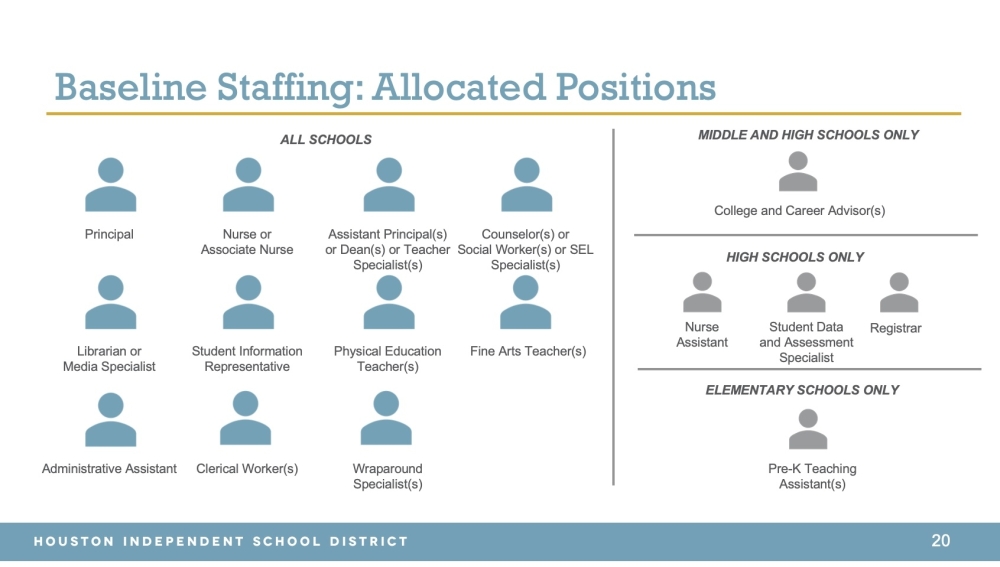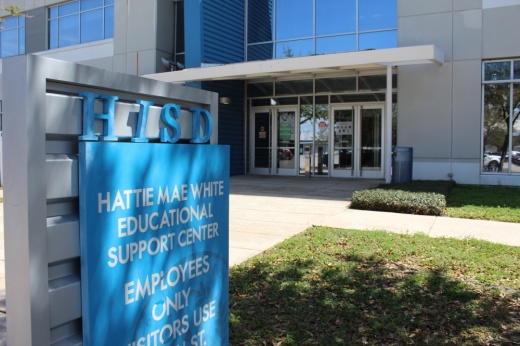Among the proposals in the plan is a shift from the district's current decentralized funding model—in which campus principals have autonomy in making almost all budget staffing and programming decisions—to a model in which each school is required to staff specific baseline positions; certain materials and services are funded from the central office; and principals can fill remaining holes using discretionary funds, which will be allocated according to a newly devised formula.
At a March 31 budget workshop, Houston ISD Superintendent Millard House II outlined the changes in more detail and explained why they are being proposed.
The district has operated under its decentralized model for more than 20 years. Also known as a PUA—or per-unit allocation—the model provides campuses with funding using a weighted formula that takes total enrollment into account as well as the characteristics and demographics of the student body.
House said there are some strengths of the model, including that principals can be flexible to meet unique needs and that there are incentives to improve academic offerings, which would theoretically lead to growing student enrollments and therefore more funding.
However, House said the system also creates inequities in that schools with lower enrollments wind up with fewer resources. As a result, some schools may find themselves unable to afford counselors, nurses, or college and career advisers.
"At schools that have limited financial resources, ... students do not have the same access to key supports and experiences given economies of scale," House said at the meeting.
The proposed hybrid model would continue to use a weighted formula to give principals discretionary funding while also providing a core baseline set of resources, House said.
Under the plan, every school in the district would be required to staff certain positions, including a nurse or nurse associate, a fine arts teacher, a wraparound specialist, and a librarian or media specialist. Middle and high schools would be required to staff a college and career adviser, while elementary schools would be required to staff a pre-K teaching assistant.

Overall, the new model would increase campus expenditures by $107 million in 2022-23, House said. In trying to capture the urgency of the situation, he said HISD has an opportunity to use its allotment of one-time coronavirus relief funds from the federal government to help make the transition.
"Today, we face the harsh reality that we currently have 47 'D' or 'F' schools while also facing declining student enrollment and a major budget deficit," House said. "Given the limited time that we have with these dollars and the urgency of the challenges we face ahead of us, we cannot afford to wait in my eyes."
Although House emphasized the district was not taking a one-size-fits-all approach, some board members and public speakers at the March 31 meeting questioned whether the new system would actually improve equity. District 5 Trustee Sue Deigaard said calling the proposed change a "hybrid" model was misleading, pointing out that less than 4% of revenue dollars would go to campuses for discretionary use, not counting one-time federal funds.
"That is not a per pupal allocation system; that is a full-time equivalent staffing model system, when such a small percentage is allocated," Deigaard said at the meeting. "If it walks like a duck, if it quacks like a duck, it’s a duck."
If the model does not change, House said the result would be "extremely difficult decisions for cuts at the campus level."
"The experiences we’re trying to protect and expand through this hybrid model tend to be the first on the chopping block when the budget shortfall is put in front of us," he said.
When it comes to the discretionary funding, Chief Academic Officer Shawn Bird said every school district will qualify for additional funding based on risk factors and institutional barriers, which include levels of child poverty, among others. The funding comes from a variety of sources, including magnet general funds, bilingual allotments, federal coronavirus relief funding and Title I allocations.
Campus-level details on how staffing models would change under the proposed model as well as how much discretionary funding each school would receive based on current enrollment projections can be found on the district's website. Each school's chart shows staffing as of January, the new allocations that would go into effect in the 2022-23 school year and the change in total positions.
At Heights High School, for example, the school would start the 2022-23 school year with 10 fewer clerical positions but would gain six college advisers, two counselors/social workers and six flex classroom teaching positions under new baseline requirements. Bellaire High School would have 15 fewer classroom positions under the baseline model.
Principals can also use their discretionary funding to add positions as they see fit, including adding back positions that would be reduced under the new model. Although discretionary funds have been calculated for each school, they are subject to change based on changes in enrollment projections, HISD officials said.
House said the district is also planning a series of 10 town hall meetings to discuss the strategic plan with the community over the next 10-12 weeks. The town halls, which will be spread out across the nine trustee districts, will allow community members to learn about changes at their schools, voice opinions on specific components of the plan and ask questions. One town hall will specifically be dedicated to magnet schools, House said at the March 31 meeting.
Additional details are expected to be released in the coming days. Once the town halls are completed, HISD's Office of Engagement will prepare a report on findings to share with trustees, House said.





